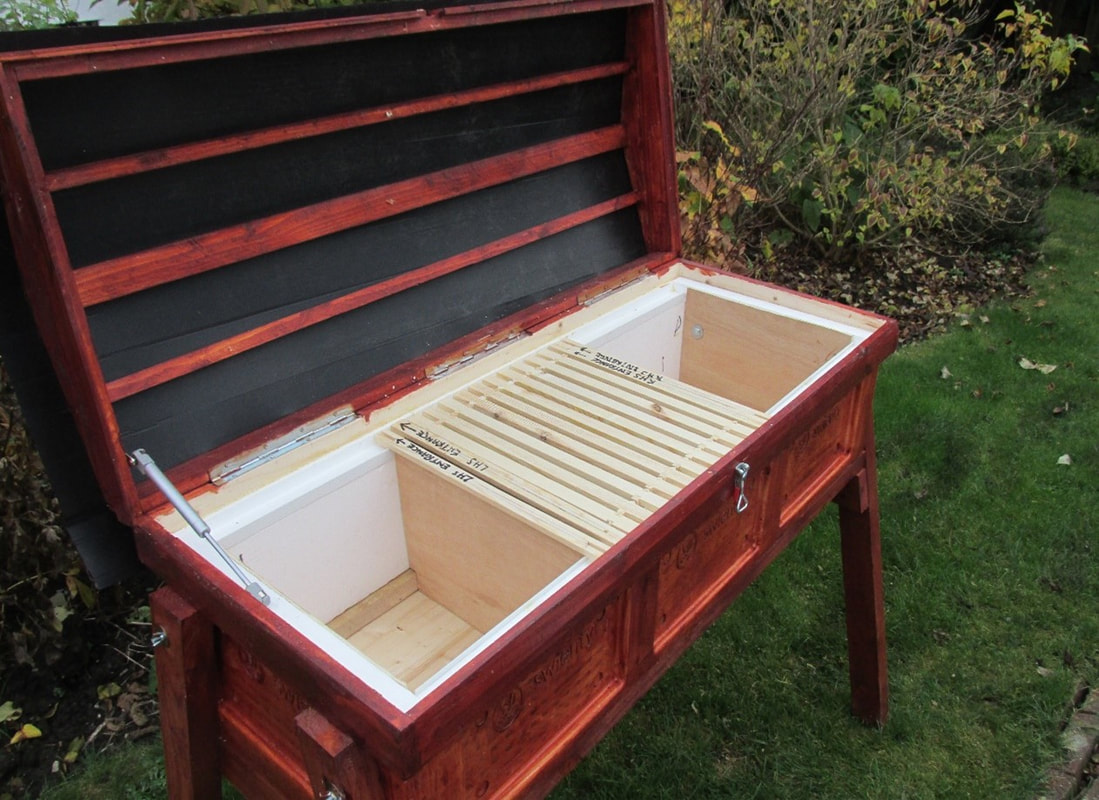|
Increasingly it seems that some of the beekeeping fraternity are realising that they are ageing and still wanting to continue with their lifelong hobby, writes Somerset BKA member Garry Rucklidge.
The lifting of supers prior to examining a brood box is no easy task with a full super weighing 40lbs (in “old money”) and a box full of brood and stores likely in excess of that. Attention of these beekeepers has been grabbed by the proliferation of the top bar or long hive. I have recently joined the ranks of gentle back pain sufferers and with an eye to the future have designed and constructed a long hive which I shall be trying next year. Based on over 40 years of beekeeping I wanted to incorporate a few features which I felt are important. Firstly the colony has to be warm and in the case of the long hive this is less achievable as heat from the brood and supers rising upwards in a standard format is just not going to happen. Heat will have to travel horizontally but helps to be somewhat retained by good insulation by the walls and above the entire colony. This can be achieved by the use of Celotex, Kingspan or polystyrene. At this point I appreciated that my woodworking skills are not sufficient to make a hive with insulated walls with a perfect bee space over the length required for a long hive. For many years I have kept my bees in a poly Langstroth hive modified so that National frames with shortened lugs are used at right angles to the direction of the Langstroth frames for which the box was designed thus utilising the insulation properties. I therefore designed the long hive using two Swienty polystyrene brood boxes which were dowelled and butt jointed using the two spare ends to increase the length which I calculated would hold 31 National Hoffman brood frames plus dummy boards and queen excluders of which more later. The big plus is that the Swienty hives arrive in the flat and go together with dovetail joints as can be seen laid out above and below, being glued clamped to a straight edge and the two sides ready for the ends to be fixed to the sides with the dove tails. Another essential was that there had to be an open mesh floor in one section of the hive and that this floor should be level with the entrance to allow easy removal of the hive debris by the bees as it was not going to be possible to lift the entire hive off the floor for cleaning. This section is built in the centre of the hive where there are 22mm holes drilled into the supporting floor and box bearers as many as you want centrally so that any mated queen will return there into the brood box area and not into the stores area. The entrance holes can be simply blocked or opened as needed with wine corks – I don’t run my poly hives with anything more than a 120 x 8mm entrance all year round in a normal set up as it is easier to defend against wasps and it keeps mice out in winter. On either side of the brood area below the store section are removable solid floors which can be dropped down and removed by turning the set of cupboard catches, then scraped and flamed before and after winter to aid hygiene. The vertical queen excluders are framed as shown and both those and the dummy boards are a perfect fit to prevent the queen getting where she is not wanted. I will be able to expand the brood area as and when required one frame at a time using the dummy board or excluder depending on flow. The roof is kept lightweight and is hinged using three piano hinges (see two above) so that it does not need to be completely lifted off for inspections. Do remember to have the entrance holes on the opposite side from where you inspect so as not to get in the way of leaving and returning bees. I intend to use linen cloths topping the frames in the different sections so not all frames are exposed at a time. These are topped with Celotex in 3 sections again not all will need to be removed in an inspection. The space below the roof is deep so a 6 litre feeder can be easily fitted in the autumn or fondant in the winter. The hive dimensions are 1220mm x 480mm, and the hive stands 780mm off the ground at the top of the brood/stores box but this can be adjusted to your own comfortable working height with angled legs for stability. I used 2mm correx sheet for the roof using 6mm car panel plastic fasteners pushed into a drilled hole in the wood framing of the roof. Solvent based paint can’t be used with poly hives but Ronseal wood stain 10 year varnish does a nice job with a glossy finish. The bees were transferred on 17 March and seem to be all settled. For more photos, see Somerset BKA's Spring Newsletter 2022. Comments are closed.
|
Archives
March 2024
Categories
All
|
Somerset Beekeepers Association Charity © 2021 Registered CIO Charity 1206483
Affiliated to the British Beekeepers Association
Click here to view our Privacy Policy
Affiliated to the British Beekeepers Association
Click here to view our Privacy Policy

 RSS Feed
RSS Feed
